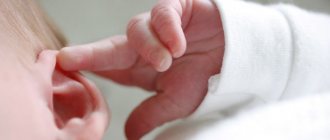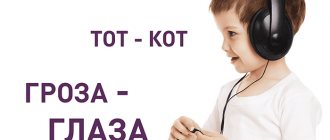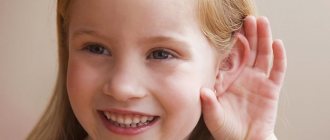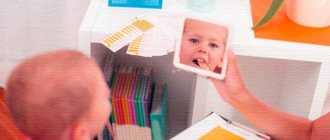Phonemic awareness is the ability of a person to distinguish, analyze and differentiate the syllables and sounds of human speech.
Phonemic hearing disorder (PHD) is not an ENT disorder. With defects in phonemic hearing, physiological hearing is usually well developed. A child may even have an ear for music. The problem is that it doesn't recognize phonemes—individual sounds—well. For example, instead of the word “porridge” he says “Kafka”, instead of “spoon” he says “loska”, etc.
With such a deviation, acoustic dysgraphia appears in children of school age. Because of this, difficulties arise with learning and correctly reproducing heard words. Spelling and learning new languages are especially difficult. But it will be difficult to succeed in other subjects - the ability to write and speak correctly will be useful everywhere. Failure in studies negatively affects a child’s self-esteem; he gets used to feeling like an outsider, and this is fixed in his subconscious. That is why it is very important to correct this deficiency before school or, if this does not happen, in primary school.
Development of phonemic hearing
Phonemic hearing begins to develop from birth. The baby first learns to distinguish everyday sounds: the sound of a hammer, the sound of water from a tap, the click of a switch. But this is not yet phonemic hearing, but its prerequisites are the discrimination of everyday object noises. The temporal cortex of the right hemisphere is responsible for this function, as well as for musical hearing, the hearing of animals and birds.
The further development of auditory perception can be divided into the following stages:
- A child aged 1-2 months begins not only to respond to environmental sounds, but also tries to repeat them (humming).
- Gradually distinguishes various intonations, practices in reproducing vowel sounds and their combinations.
- Then he learns to distinguish the rhythmic pattern of a word. Already repeats sounds and straight open syllables after adults.
- By about 8 months, the baby uses only those sounds that are present in his native speech (babble).
- At 1-2 years of age, proof of the correct development of phonemic hearing will be the child’s understanding of the speech with which adults address him. He is able to carry out simple instructions, such as: “bring the doll”, “sit on the typewriter”. It also gives adequate answers to basic questions: “where is mom?”, “Are you thirsty?”
- At normal rates of intellectual development, by the age of 3, a child’s phonemic hearing is practically formed; he is able to recognize incorrect pronunciation and distinguish native from foreign speech. Also, at the age of 3-4 years, the child should have back-lingual sounds (H-K-G). If a child pronounces them incorrectly (“kh” instead of “k”) or replaces one sound with another (“D” instead of “G”), then the reason may also be a violation of phonemic hearing.
- At 4-5 years old, a child without deviations well masters the technique of pronunciation of most sounds (except for hissing-whistles and R-L, which normally should appear before the age of 6-7 years). If this does not happen, then there is a violation of phonemic hearing, which must be eliminated in order to avoid problems with pronunciation and learning in the future.
In the process of forming speech hearing and developing speech in a child, the temporal zone of the right hemisphere first develops, and then (at about 1.5 years) the left hemisphere begins to specialize in speech. Accordingly, the temporal cortex of the right hemisphere remains “responsible” for rhythms, music and object noise, and phonemic hearing is “settled” in the temporal cortex of the right hemisphere. Thus, with a severe variant of impaired understanding of addressed speech (speech auditory agnosia), a child can understand intonations, respond to music, even use realistic onomatopoeia of animals, but at the same time not understand human speech.
Second phase
At the next level, you need to show the child the difference in the quality of human speech.
• “Who is speaking?” Record on a voice recorder the voices of adults familiar to the child (mother, grandmother, father, brother or sister) and, of course, the voice of the baby himself. The path guesses who the voice belongs to.
• "Three Bears". This is a simulation exercise. Read the story of the three bears together and then speak for the characters. The child should guess when mommy bear, daddy bear and cub speak.
• “Loud or quiet?” Think of actions that the child should perform when his mother’s voice is quiet and when his voice is loud.
Signs of phonemic hearing impairment
As mentioned above, the most severe type of auditory speech perception disorder is auditory speech agnosia. When phonemic hearing is impaired, the child develops FFSD (phonetic-phonemic speech disorder). In preschool children it manifests itself as follows:
- The pronunciation of individual sounds is impaired, not due to a violation of articulation. For example, voiced sounds can be replaced by voiceless or similar ones; hissing and whistling sounds predominate in speech. “Kladrat” instead of “square”;
- The child skips or swaps consonants and vowels in words. Instead of the word “machine” - “manisha”, “mshina”; “turn” instead of “turn”;
- Softening consonants where this is not required, or, conversely, pronouncing a hard consonant instead of a soft one: “karyandash” instead of “pencil”, “pyu” instead of “drink”, “song” instead of “song”.
- Missing words in speech or syllables in words.
Impaired phonemic hearing can lead to dyslalia.
Schoolchildren exhibit the following signs of FFND:
- Phonological writing (writes as it hears);
- Substitution of soft characters or their omission. “Bear” - “bear”, “wound” - “wound”, etc.;
- Missing words in sentences, syllables in words. Prepositions and particles are usually skipped: “I’m driving,” “Let’s go shopping”;
- Grammatical errors in writing - unstressed vowels are omitted, consonants are doubled, incorrect placement of a soft separating sign, which is defined as acoustic dysgraphia during diagnosis.
- The inability to determine the correct stress in a word because the child does not hear the stressed sound; for him it is similar to an unstressed sound.
How do we hear
Find out how the ear works and how it functions. This will help you identify conditions and conditions that affect your child's hearing.
The human ear consists of three sections: outer, middle and inner.
- The outer ear is the pinna. It collects and transmits sound waves through the external auditory canal to the eardrum.
- The middle ear has a complex structure: it is a cavity in the temporal bone formed by three tiny auditory ossicles - the malleus, incus and stapes. The middle ear conducts sound waves from the eardrum to the inner ear.
- The cochlea is part of the inner ear, through which the brain receives sound signals. The chambers of the cochlea are filled with fluid, which vibrates when the ossicles of the middle ear move. This stimulates the sensory hair cells in the inner ear, which convert sound vibrations into electrical impulses.
Electrical impulses entering the auditory nerve are what our brain perceives as the sound we hear. Disturbances at any part of this chain - be it an ordinary cerumen plug in the ear canal, swelling due to inflammation of the middle ear, rupture of the eardrum, damage to the bones or nerves - will become an obstacle to good hearing in a child.
Causes of phonemic hearing impairment
Since the left hemisphere of the brain is responsible for phonemic hearing, the state of this particular zone is very important. When examining children with FS disorders, the following are often revealed:
- Problems of blood supply to the brain (for example, increased intracranial pressure, venous congestion, dilatation of the cerebral ventricles, especially on the left);
- Disturbance in the conduction of auditory impulses at the level “to the cortex,” especially from the right ear to the left hemisphere (detected by examination using the evoked potentials method). This is not a gross hearing impairment (as a rule, an ENT doctor writes in this case: “normal”), but it manifests itself precisely when perceiving speech sounds at certain frequencies.
- On the EEG, children with FFND also have a disturbance of electrogenesis in the area of the left temple (but not necessarily).
Thus, we can say that FS disorder is a neurological, neurophysiological disorder, which is most often caused by problems of pregnancy and childbirth. In addition to phonemic hearing impairment, such children often have associated problems: hyperactivity, behavioral problems, nutritional problems, and emotional-volitional problems.
Building the future
For more than 40 years, Phonak has been developing and introducing innovative technologies for children with hearing impairments into audiological practice. High-tech solutions from Phonak have helped hundreds of thousands of young hearing impaired patients integrate into a normal communication environment.
This manual is intended for parents whose children are healthy or already suffer from hearing loss. After reading it, you will learn about the causes of the problem, the prevention of hearing loss, and how to help your child find the wonderful world of sounds if he has difficulty hearing. Good luck!
Diagnostics
If you suspect your child has FFND, it is important to seek help from a speech therapist. At the first appointment, the specialist must conduct a mandatory examination of phonemic hearing. To do this, the following procedures are carried out: the child determines the source of the sound, distinguishes similar words, differentiates syllables and phonemes, sound analysis.
In our center, we also recommend that you undergo a consultation with a neuropsychologist and bring the necessary conclusions based on the results of an EEG, an examination using the method of evoked potentials (ASVP, EVP), Dopplerography and a neurologist’s report to understand the full picture of the child’s development.
Based on the results of all diagnostic procedures, the teacher draws up an individual program for correcting defects.
My child has IV degree hearing loss or deafness, how can I help him?
Your child can be helped as soon as he is one year old: in the most severe cases, cochlear implants come to the rescue.
A cochlear implant is an electronic medical device surgically inserted into the inner ear.
The implant replaces damaged areas of the ear structure or nerve circuit. The device also has an outer part that looks like a regular hearing aid and includes a microphone, speech processor and receiver. A cochlear implant is indicated for children aged 1 year and older who suffer from grade IV hearing loss or deafness in both ears, and there is no effect from wearing hearing aids.
Correction of violation
To develop phonemic hearing, first of all, regular classes with a speech therapist are needed. Our center also successfully uses the Tomatis method of neurosensory auditory stimulation to improve auditory-verbal and phonemic perception. Listening to a special program using bone conduction headphones expands the range of frequencies perceived by the brain, including those at which the temporal cortex recognizes speech sounds. Auditory-verbal attention also improves.
During speech therapy sessions, our center’s specialists use a Forbrain headset, which also has bone conduction and special dynamic filters. With the help of this device, a child with phonemic hearing impairment begins to hear his mistakes and can correct them. With regular practice with Forbrain, speech improves, its fluency, pronunciation, rhythm and musicality, auditory discrimination and memory.
Correction of FFNR should be carried out comprehensively. A speech therapist conducts classes, and a neurologist prescribes therapy aimed at eliminating problems in the functioning of the nervous system (normalizing the functioning of blood vessels, nourishing the brain, etc.). In addition to classes with a speech therapist, parents should work with their child at home. To do this, the specialist gives homework.
Exercises on the ability to distinguish words that sound similar
- "What did I say?" Place pictures of different objects in front of your child. Name words that sound similar (lac-rac-mac, mouse-bear), the child must show a card with the desired picture.
- “Correct the mistake.” Children love to correct adults. Ask them to find mistakes in your words - “We have hats on our feet, we’ll wear slippers outside,” etc.
- “Rhymes” - when reading poetry, pause at the end of the quatrain, let the child finish the sentence himself. Many riddles are built on this same principle.
- "Applause". Show the picture and ask the child to clap if you name it correctly. For example, hat-slub-gag.
Exercises and games to develop phonemic awareness
Game "Catch the Sound". The adult says a word, and the child’s task is to clap his hands when pronouncing a pre-agreed sound. First, choose words that begin with the desired sound. Then complicate it - the sound should be in the middle or end of the word. The task can be varied to make it more interesting for the child, and also to develop various channels of sound perception. To do this, tell your child words from the next room. After some time, you should read the text in which he will catch the desired sound. This method perfectly trains attention and concentration.
Game "Say the word." The child is told the beginning of a phrase, and he must finish it: to play, you need a game, to sew, you need... (a needle). Come up with as many similar consonances as possible.
Play Rhymes. Say a word and throw the ball to the child. He must catch it and say a rhyme in response. If the rhyme is not named, say it yourself. Start with very simple words and gradually move on to more complex ones. The game is designed for children aged 4-5 years and older.
To make an appointment with a speech therapist or neuropsychologist, call...
First stage
The initial stage of work allows you to create a base, a foundation for the development of fine hearing and is suitable for very young children. What do we have to do? Play! For example, the game “Guess what it sounds like.” Everyday situations can be played out: the sound of pouring water, the clinking of dishes, a person’s steps, a cat’s meowing, the rustling of paper.
Other exercises for this stage:
• “Magic sounds”. Together with your child, fill woven bags, opaque plastic containers, or just matchboxes with any “sounding” materials: cereal, metal clips, buttons. You need to guess by the sound what's inside.
• Regular “Zhmurki” is perfect for solving phonemic problems. The child needs to move towards an agreed sound, for example, clapping hands or ringing a bell.
• "Magic Pencil". Give your child a regular pencil and ask him to tap objects of different textures made of wood, glass, metal, and paper.
• “Clap!” The child needs to repeat after the adult the rhythm of clapping and alternating pauses of different lengths. First, the exercise is done with open eyes, then you can make it more difficult: blindfold your eyes with a scarf or simply close them.
To understand how to practice, watch informational videos about the development of phonemic hearing. The video will help you not only understand the logic of the lesson, but also master the most effective working techniques.
My child wears a hearing aid, but still has trouble hearing at school.
The hearing care industry includes not only hearing aids, but also many useful accessories that allow children to communicate with each other, listen to music, watch TV, and exchange information using Bluetooth devices. A very convenient device is the Roger FM System.
This wireless technology will be useful for the student. The use of Roger-based platforms in the educational process allows the child to perceive information on an equal basis with everyone else. This is a digital radio system that picks up sound signals and transmits them to the user's hearing analyzer without distortion. Roger makes speech clear and understandable, even in noisy environments. The Roger system includes one or more wireless microphones directed at the speaker (this could be a parent at home or a teacher at school) and receivers attached or integrated into the hearing aid.
Forms of dyslalia
There are two forms of dyslalia - functional and organic or mechanical. If the child does not have organic disorders caused by the peripheral or central nervous system, we can talk about functional dyslalia.
This type appears in childhood, when the correct pronunciation of sounds is learned. Mechanical speech can appear at any age due to disturbances in the peripheral speech apparatus.
Functional dyslalia includes defects in the pronunciation of sounds - phonemes, without mechanical articulation disorders. Its causes are: physical weakness due to somatic diseases;
- delayed psychological development (minor disturbances in brain activity);
- delays in speech development;
- disorders associated with phonetic perception;
- social environment (incorrect speech of adults, insufficient communication with other children and adults, insufficient attention to raising the child).
All these reasons are not critical and can be eliminated by the work of qualified psychologists, speech therapists and other child development specialists.
Pathogenesis of dyslalia
The reasons vary for different types. Accordingly, the correction required is different.
Physiological prerequisites for mechanical dyslalia
The mechanical type is caused by physiological and anatomical defects. They do not make it possible to pronounce sounds correctly, the sound that they heard. This usually occurs due to dental defects - bite, incorrect shape and location of incisors, underdeveloped jaws. Doctors consider the main reasons:
- the frenulum of the tongue is too short;
- structural features of the bones of the jaw and face;
- palate defects;
- pathology of the upper lip;
To get rid of mechanical dyslalia, a dentist and an orthodontist are needed. The child must undergo a special correction course. The best results are achieved at the age of 5-6 years.
Cases when medication or physiotherapeutic treatment is necessary
If there is an organic cause of dysgraphia, then its treatment will be prescribed (medication, physiotherapy, and so on). Similar methods of treatment are prescribed for aggravated disorganization of written speech, leading to the impossibility of writing (Agraphia). Various exercises will be carried out with a speech therapist. You can apply some of them yourself and work with your child at home, in this way you will not only help with the correction, but also get closer to your baby.
Features of the course of complex dyslalia
The more complex the combination of disorders, the more difficult it is to cope with it. Accordingly, this affects the general background of the disease. In complex forms, mental and general developmental delays may be observed. It is necessary to engage in in-depth research of the child in the aspect of his psyche, intellectual development, hearing, and vision. Complex dyslalia may be a signal that there are problems with them. People who are hard of hearing often distort or change the “T” sound.
A child with second or third degree hearing loss does not have a metallic tone in his voice. The voice has softness or, in other words, viscosity. Children with vision problems may have dyslalia defects corresponding to its complex types. This is caused by poor visual control. In such patients, sigmatism is observed 4 times more often than in healthy children.
Prevalence of the problem
Dyslalia is a common problem. There are different estimates on this matter, on average, the number of children suffering from this speech disorder is about 25-30% in preschool age. As you get older, this number decreases. At primary school age this percentage drops to 17-20%. At older ages there are only 1-2% of such children.
The disease is a common occurrence, most common in the practice of speech therapists. According to various estimates, the average number of children with such problems in preschool age is 25-30%, in elementary grades – 17-20%, and in older age – 1%.
More often in the practice of speech therapists there are combined articulation disorders that create a barrier to the development of writing. Children, at the same time, have an extensive vocabulary, the structure of speech is not disturbed. All grammatical laws are observed - cases, declensions, endings.
Measures to prevent dyslalia
The main preventive measures are:
- For full speech development and the formation of the articulatory apparatus, the child must receive solid food.
- Speech disorders occur in children who receive only soft foods more often than in others.
- It is necessary to develop the child's fine motor skills.
- Identify existing speech disorders and begin to eliminate them.
Attention to the child’s speech problems and adequate correction will help avoid negative consequences and eliminate all problems in a timely manner.

![Hard and soft sound [d]](https://ls-kstovo.ru/wp-content/uploads/tverdyj-i-myagkij-zvuk-d3-330x140.jpg)






